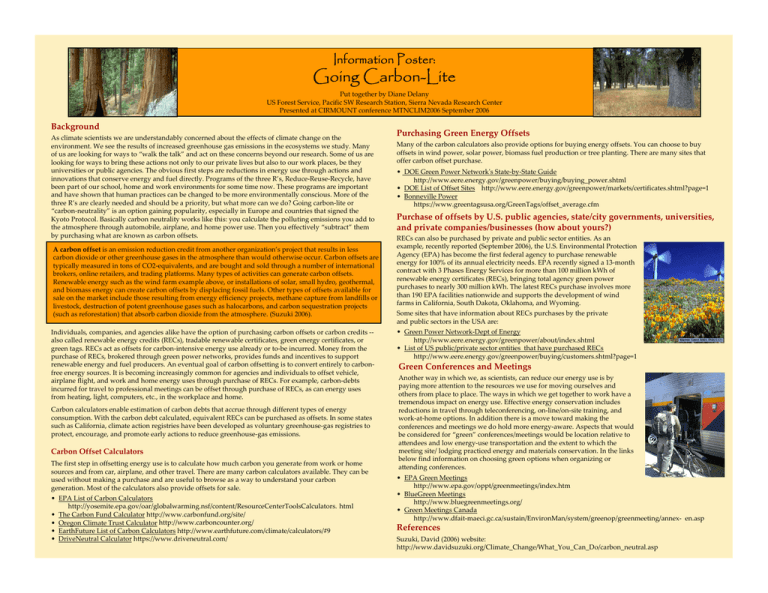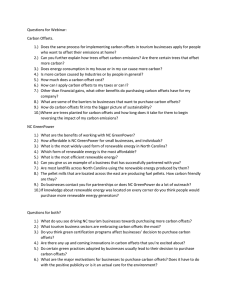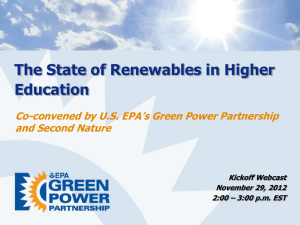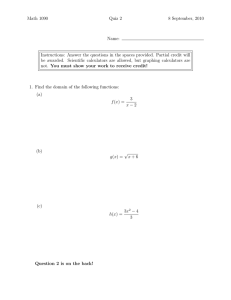Going Carbon-Lite Information Poster:
advertisement

Information Poster: Going Carbon-Lite Put together by Diane Delany US Forest Service, Pacific SW Research Station, Sierra Nevada Research Center Presented at CIRMOUNT conference MTNCLIM2006 September 2006 Background As climate scientists we are understandably concerned about the effects of climate change on the environment. We see the results of increased greenhouse gas emissions in the ecosystems we study. Many of us are looking for ways to “walk the talk” and act on these concerns beyond our research. Some of us are looking for ways to bring these actions not only to our private lives but also to our work places, be they universities or public agencies. The obvious first steps are reductions in energy use through actions and innovations that conserve energy and fuel directly. Programs of the three R’s, Reduce-Reuse-Recycle, have been part of our school, home and work environments for some time now. These programs are important and have shown that human practices can be changed to be more environmentally conscious. More of the three R’s are clearly needed and should be a priority, but what more can we do? Going carbon-lite or “carbon-neutrality” is an option gaining popularity, especially in Europe and countries that signed the Kyoto Protocol. Basically carbon neutrality works like this: you calculate the polluting emissions you add to the atmosphere through automobile, airplane, and home power use. Then you effectively “subtract” them by purchasing what are known as carbon offsets. A carbon offset is an emission reduction credit from another organization’s project that results in less carbon dioxide or other greenhouse gases in the atmosphere than would otherwise occur. Carbon offsets are typically measured in tons of CO2-equivalents, and are bought and sold through a number of international brokers, online retailers, and trading platforms. Many types of activities can generate carbon offsets. Renewable energy such as the wind farm example above, or installations of solar, small hydro, geothermal, and biomass energy can create carbon offsets by displacing fossil fuels. Other types of offsets available for sale on the market include those resulting from energy efficiency projects, methane capture from landfills or livestock, destruction of potent greenhouse gases such as halocarbons, and carbon sequestration projects (such as reforestation) that absorb carbon dioxide from the atmosphere. (Suzuki 2006). Individuals, companies, and agencies alike have the option of purchasing carbon offsets or carbon credits -also called renewable energy credits (RECs), tradable renewable certificates, green energy certificates, or green tags. RECs act as offsets for carbon-intensive energy use already or to-be incurred. Money from the purchase of RECs, brokered through green power networks, provides funds and incentives to support renewable energy and fuel producers. An eventual goal of carbon offsetting is to convert entirely to carbonfree energy sources. It is becoming increasingly common for agencies and individuals to offset vehicle, airplane flight, and work and home energy uses through purchase of RECs. For example, carbon-debts incurred for travel to professional meetings can be offset through purchase of RECs, as can energy uses from heating, light, computers, etc., in the workplace and home. Carbon calculators enable estimation of carbon debts that accrue through different types of energy consumption. With the carbon debt calculated, equivalent RECs can be purchased as offsets. In some states such as California, climate action registries have been developed as voluntary greenhouse-gas registries to protect, encourage, and promote early actions to reduce greenhouse-gas emissions. Carbon Offset Calculators The first step in offsetting energy use is to calculate how much carbon you generate from work or home sources and from car, airplane, and other travel. There are many carbon calculators available. They can be used without making a purchase and are useful to browse as a way to understand your carbon generation. Most of the calculators also provide offsets for sale. • EPA List of Carbon Calculators http://yosemite.epa.gov/oar/globalwarming.nsf/content/ResourceCenterToolsCalculators. html • The Carbon Fund Calculator http://www.carbonfund.org/site/ • Oregon Climate Trust Calculator http://www.carboncounter.org/ • EarthFuture List of Carbon Calculators http://www.earthfuture.com/climate/calculators/#9 • DriveNeutral Calculator https://www.driveneutral.com/ Purchasing Green Energy Offsets Many of the carbon calculators also provide options for buying energy offsets. You can choose to buy offsets in wind power, solar power, biomass fuel production or tree planting. There are many sites that offer carbon offset purchase. • DOE Green Power Network's State-by-State Guide http://www.eere.energy.gov/greenpower/buying/buying_power.shtml • DOE List of Offset Sites http://www.eere.energy.gov/greenpower/markets/certificates.shtml?page=1 • Bonneville Power https://www.greentagsusa.org/GreenTags/offset_average.cfm Purchase of offsets by U.S. public agencies, state/city governments, universities, and private companies/businesses (how about yours?) RECs can also be purchased by private and public sector entities. As an example, recently reported (September 2006), the U.S. Environmental Protection Agency (EPA) has become the first federal agency to purchase renewable energy for 100% of its annual electricity needs. EPA recently signed a 13-month contract with 3 Phases Energy Services for more than 100 million kWh of renewable energy certificates (RECs), bringing total agency green power purchases to nearly 300 million kWh. The latest RECs purchase involves more than 190 EPA facilities nationwide and supports the development of wind farms in California, South Dakota, Oklahoma, and Wyoming. Some sites that have information about RECs purchases by the private and public sectors in the USA are: • Green Power Network-Dept of Energy http://www.eere.energy.gov/greenpower/about/index.shtml • List of US public/private sector entities that have purchased RECs http://www.eere.energy.gov/greenpower/buying/customers.shtml?page=1 Green Conferences and Meetings Another way in which we, as scientists, can reduce our energy use is by paying more attention to the resources we use for moving ourselves and others from place to place. The ways in which we get together to work have a tremendous impact on energy use. Effective energy conservation includes reductions in travel through teleconferencing, on-line/on-site training, and work-at-home options. In addition there is a move toward making the conferences and meetings we do hold more energy-aware. Aspects that would be considered for “green” conferences/meetings would be location relative to attendees and low energy-use transportation and the extent to which the meeting site/ lodging practiced energy and materials conservation. In the links below find information on choosing green options when organizing or attending conferences. • EPA Green Meetings http://www.epa.gov/oppt/greenmeetings/index.htm • BlueGreen Meetings http://www.bluegreenmeetings.org/ • Green Meetings Canada http://www.dfait-maeci.gc.ca/sustain/EnvironMan/system/greenop/greenmeeting/annex- en.asp References Suzuki, David (2006) website: http://www.davidsuzuki.org/Climate_Change/What_You_Can_Do/carbon_neutral.asp



